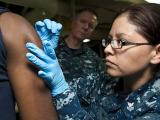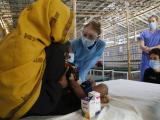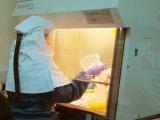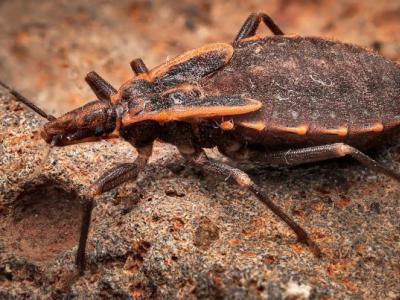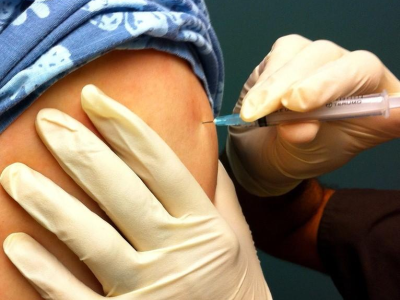Medical investigators never were able to discover the source of the spores that made a Florida man severely sick with inhalational anthrax after a western vacation in August 2011, according to recent reports in Emerging Infectious Diseases (EID).
The man, age 61 at the time, fell ill on the return trip and was hospitalized in Minnesota for more than 3 weeks. Early diagnosis and treatment with appropriate antibiotics and anthrax immune globulin (AIG) were credited for his recovery.
Needle fragment in a haystack
The patient and his wife had traveled through Montana, Wyoming, and the Dakotas during their trip, making it nearly impossible to figure out how and where he might have been exposed to Bacillus anthracis, the bacterium that causes anthrax, says the report on the case investigation. The disease occurs in grazing animals, and the hardy spores can endure in soil for many years.
During their trip, the couple "walked in national parks, collected loose rocks, and purchased elk antlers," says the report by Minnesota, Florida, and federal health officials. "On July 29 they drove through herds of bison and burros, frequently stopping while animals surrounded their vehicle."
Jayne Griffith, MA, MPH, lead author of the report, said she and her colleagues talked at length about whether to try to take samples at sites the patient and his wife had visited. "We discussed it, but the difficulty was that they covered a couple thousand miles, and it was going to be quite difficult to identify each area in particular where they might've walked around, with any timeliness," she told CIDRAP News.
To make the problem even tougher, the patient couldn't talk for about 10 days during the critical phase of his illness, and his wife's memory was imperfect because of the stress of the situation, Griffith said. Once the patient was able to talk again, his memory was a little impaired because he had been intubated and critically ill.
"If there were all the economic resources in the world to do it, it probably would've been undertaken, but the consensus was it would be like finding the tip of a needle in a haystack," she said.
Auto air filters checked
Given the circumstances, discussion eventually focused on the couple's car, and especially its air filters. "That was the closest thing we could come to that might yield spores and sort of cover the large area they had traveled," Griffith said.
So investigators took 47 environmental samples from the man's car and contents, including air filters, and 18 samples from his garage and home workshop, where he made metal and stone jewelry and knives with elk-antler handles. Among the samples were fishing flies the patient had made from elk hair a month before he got sick. But all the samples tested negative for B anthracis.
On another investigative front, state and federal agencies in Minnesota, North Dakota, Montana, Wyoming, South Dakota, and Florida hunted retrospectively for evidence of other possible human or animal anthrax cases between Jun 1 and Aug 31, 2011, the report says. The search extended to about 450 laboratories.
"We talked with our veterinary partners in the states and the National Park Service. Had they identified any [animal] die-offs, we would've sampled those areas. But there were none," Griffith said.
Investigators did find one bovine anthrax case in South Dakota, but the strain was unrelated to the one that infected the Florida man. The latter was most closely related to the strain involved in a cutaneous anthrax case in New Jersey in 1965. The patient in that case worked at a gelatin factory that used bone imported from India.
Griffith said one of the features that made the Minnesota case highly unusual was that the patient and his wife had no unusual exposures. Their trip was "a very typical vacation for an older couple," she said. "Certainly people have more significant exposures than they did and don't get ill."
Third US inhalation case since 1976
A separate EID report describes the course of the man's illness and treatment. His illness was only the third naturally acquired case of inhalation anthrax reported in the United States since 1976 and the second since the cases caused by the anthrax mailings in 2001. In that episode, 22 people were sickened and 5 died after anthrax spores were mailed to several media offices and two US senators.
In the Florida man's case, anthrax was suspected on his second day of hospitalization and was confirmed a day later. On day 4 his doctors asked the Centers for Disease Control and Prevention for AIG, a product derived from the serum of people vaccinated against anthrax, which they received and began administering the next day to supplement antibiotics.
In addition to using antibiotics and AIG, the doctors drained fluid from the patient's right pleural space. His condition gradually improved after the sixth day of hospitalization.
The report says this case marks only the third time AIG has been used to treat a patient, as far as the authors know. They say no clinical studies have reported on the efficacy of AIG as treatment for anthrax, but the use of polyclonal anthrax antibodies has reduced mortality in animal studies of inhalation anthrax.
"AIG administration in the current case was associated with a reduction in toxemia, although the role of passive immunization in anthrax treatment needs further evaluation," they conclude.
Griffith J, Blaney D, Shadomy S, et al. Investigation of anthrax case, United States. Emerg Infect Dis 2014 Feb;20(2) (Early online release) [Full text]
Sprenkle M, Griffith J, Marinelli W, et al. Lethal factor and anti-protective antigen IgG levels associated with inhalation anthrax, Minnesota, USA. Emerg Infect Dis 2014 Feb;20(2) (Early online release) [Full text]
See also:
Aug 30, 2011, CIDRAP News story on anthrax case treatment
Aug 10, 2011, CIDRAP News story on anthrax case investigation




